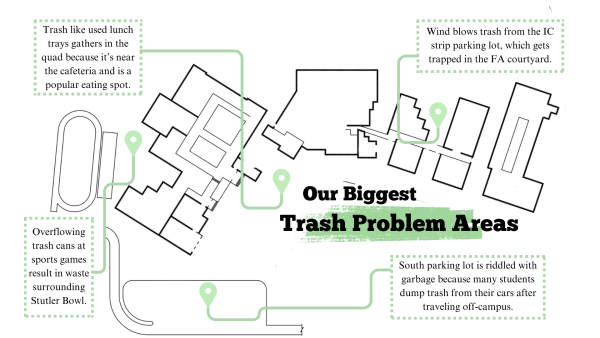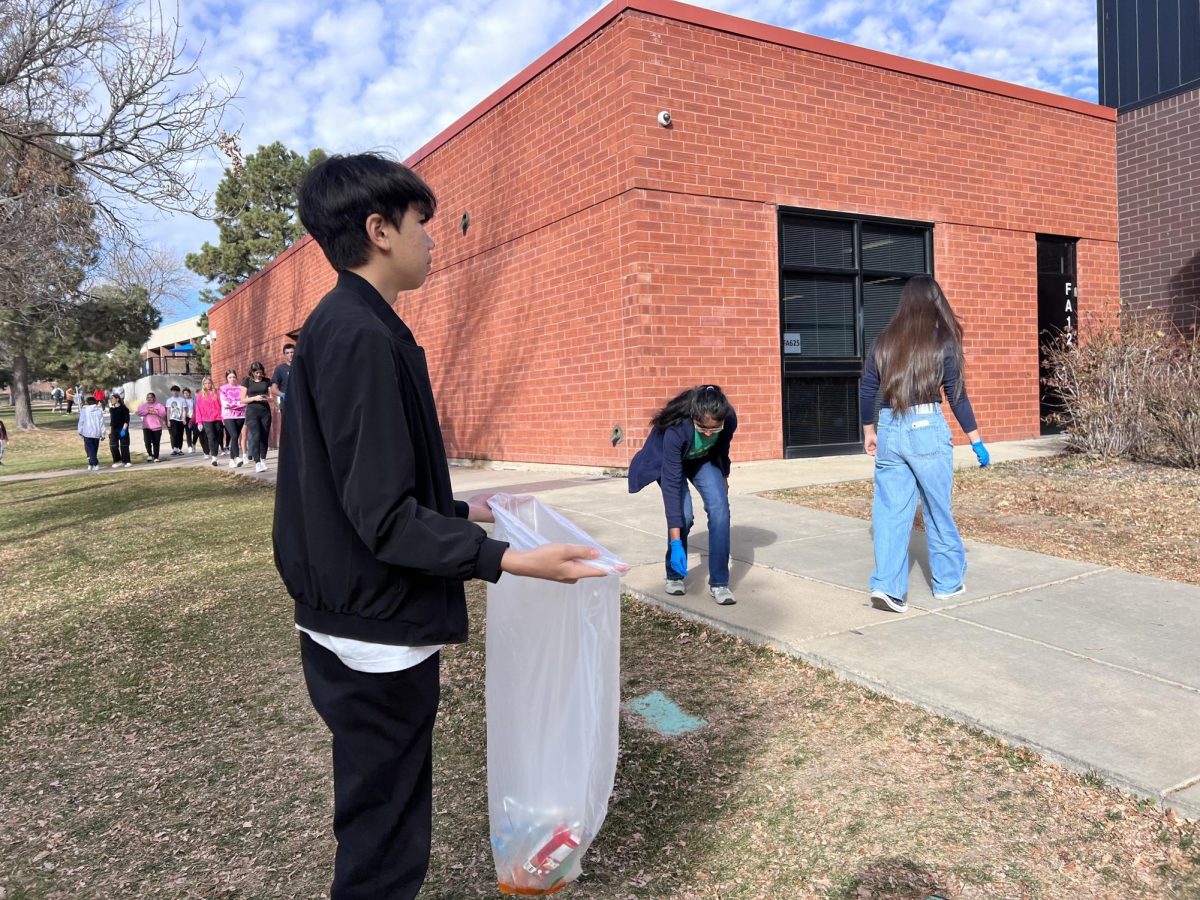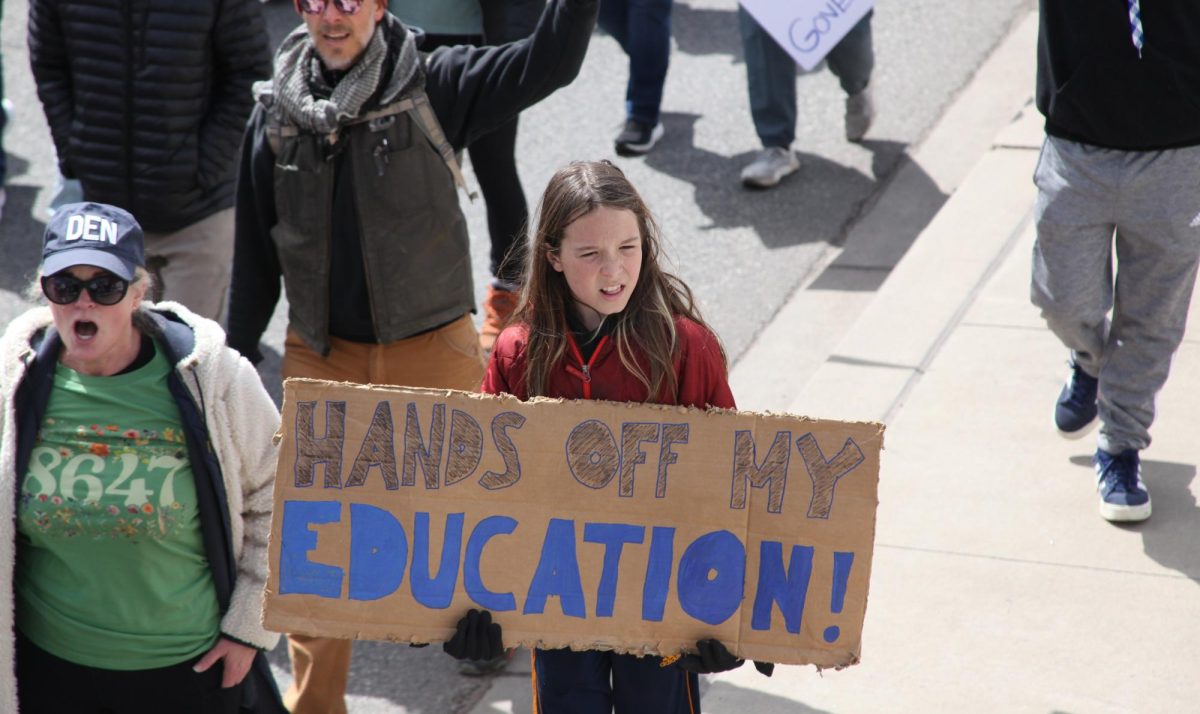Every weekday morning, at 6:30 AM, Creek maintenance staffer Tyjuan Martin begins his trudge about campus, collecting trash bag after trash bag from the exterior trash cans of Creek, Campus Middle School, and Belleview Elementary School.
147 cans, 75 acres. It takes him four hours to complete the process.
“[My job] does have some challenges, such as working around the kids and time management,” Martin said. He’s done similar jobs, but never for such a colossal area.
Cherry Creek School District grounds manager Mike Cochran says his job is a challenge. “[Martin] is spending 4 hours a day removing and replacing the trash bags in the trash cans only,” Cochran said. “He then spends another 2 hours picking up litter in the parking lot the best he can.”
Martin says he is doing a job meant for a whole team, all alone. And understaffing is just the beginning of Creek’s garbage problem. According to Principal Ryan Silva, wind blows trash out of trash cans and squirrels nudge and shove trash all over the ground.
Silva says the root of all these problems is students improperly disposing of their trash.
Martin is just one of the puzzle pieces in making the Creek campus cleaner, but recently, the administration has involved students and teachers in the process. Campus Administrator Brynn Thomas is a primary contributor to a new project, which gives advisory classes the chance to help in campus cleanup.
Thomas created a map, assigning advisory teachers and their classes areas around campus. “It’s unrealistic for a person or even…multiple people to be able to go around and pick up the trash,” she said. “Kids need to do their part, adults need to do their part…to get [trash] into a trash can.”
Martin, on his morning trash collection, notices piece after piece of trash that has escaped a trash can. “Students can pick up after themselves and not overload trash cans,” he said.
Cochran believes that Martin should not be solo in his job. “I have always advocated that Creek and the surrounding area needs a minimum of 2 personnel to handle the tasks at ground level,” Cochran said. “Until that day comes, we must work together as a team to ensure that Creek remains the staple of the community.”
Along with advisory cleanups, some groups like cross country and DECA have done organized events. Sophomore Judd Ross noticed that in the cross country cleanup, students were much more excited than the designated advisory cleanup days. He said students were unenthused when they heard that homework time would be replaced by the cleanup.
“I feel like many students aren’t dedicated to the effort,” Ross said. “They don’t really care about the cleanliness of the school and find it annoying that they have to go clean up during advisory.”
Ross doesn’t see the advisory cleanups being a sustainable solution. “The advisory effort is not going to have much of an effect because a bunch of unmotivated teenagers going out to clean one day a week isn’t enough to keep the campus clean,” he said. “The root of the problem…is littering. With well over 3,000 students at Creek, the campus gets dirty fast.”
Environmental science teacher Jeff Boyce focuses on the effects of leaving trash outside of trash cans, and how it affects local ecosystems and residential areas.
“If we’ve got loose garbage flying around on campus, it tends to settle in aquatic systems,” Boyce said. “We can go down to Cherry Creek Reservoir and we can see [trash] there. It’s not boaters and people on the beach that are dumping garbage into the reservoir.”
Even though Boyce has an advisory class, he was not assigned to an area on Thomas’s map. He chose to bring his class to pick up behind West building, in the parking lots adjacent to Stutler Bowl.
Despite campus-wide and his own efforts, Boyce doesn’t think the advisory cleanups will solve the problem.
“I think the scale is too big,” he said. “I think the biggest piece of this is that the bulk of our community lacks an environmental ethic and lacks the willingness to properly dispose of their waste.”
According to Boyce, the common culprit for much of the trash on campus is the school cafeteria. “The most effective thing we can do is reduce the amount of waste generated in the cafeteria. Everything is single-use,” Boyce said.
He also called out students for dropping their trash on the roads or parking lots after driving off-campus for lunch. “I’ve seen kids driving down the road, and when they’re done eating, they throw their bag out the window,” Boyce said.
Silva hopes that students can care for the campus as an organization, but also cites them as the primary contributor to trash. “There’s a lot of layers so I don’t want to pretend like it’s just one group who gets to own it all,” Silva said. “I would say that the majority is just our students not being careful and thoughtful.”
He hopes advisory cleanups can become less common. “The taxpayers pay for this…students should go to school where it’s clean,” he said. “By creating an awareness and all of us having ownership, I hope that will change some habits.”











